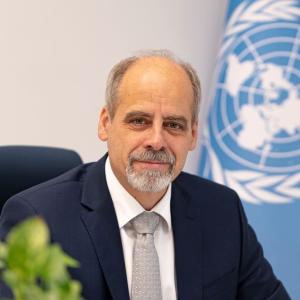Global Energy Transition: A Necessary Shift
Ladies and Gentlemen,
The world is at a pivotal moment. As countries face increasing climate challenges, renewable energy has become more than just an option; it is THE key solution for sustainable development and a core component of long-term economic growth. It can reverse and end pollution, meet growing energy demands, and connect billions of people to affordable power and electricity. But it also presents a tremendous economic opportunity, promising to be a trillion-dollar business.
Hence renewable energy is no longer a niche sector, but has registered record breaking growth since 2020 and has become a dominant part of the global energy mix. Renewable energy sources are abundant and increasingly cheaper, healthier, and more job-creating compared to fossil fuels. According to the International Renewable Energy Agency (IRENA), 90% of the world’s electricity can come from renewable energy by 2050 – that is only in 25 years.
Iran’s potential
Iran has immense potential in this area, particularly in solar and wind energy. With its rich natural resources and geographic advantages, Iran is well-positioned to become a leader in renewable energy in the region. Iran is estimated to have a potential to generate 20,000 MW in terms of wind power alone. And nearly 300 days of sun in the year indicate enormous solar power potential. But realizing this potential requires bold action and a coordinated effort from all sectors.
It is acknowledged that Iran faces also challenges that complicate this transition. The availability of heavily subsidized hydrocarbons has, in many ways, stifled the growth of renewables by making fossil fuels economically attractive in the short term. Moreover, sanctions present challenges for foreign investment and limit access to crucial technology, financing, and partnerships.
Yet, despite these obstacles, I believe Iran has the capacity and the determination to turn challenges into opportunities.
According to the Seventh Progress Plan, Iran aims to increase its renewable energy capacity to 12,000 megawatts and produce 21,000 million kilowatt-hours of renewable electricity by 2028. SATBA’s Vision 2031 aims to increase renewable energy power production to 30,000 MW. While over 80% of Iran's electricity is currently generated from thermal sources, Iran is well positioned to source more of its national energy supply from renewable sources.
Today, we gather to explore how we can accelerate this transition, leveraging Iran’s unique strengths to enhance renewable energy supply and consumption across the country.
Opportunities for Change: Towards a Greener Future
As already mentioned we need to recognize that shifting to renewable energy is not just an environmental imperative but also an economic one. The global energy transition offers Iran a chance to diversify its energy portfolio, reduce its dependency on fossil fuels, and create new jobs in a growing sector. Renewable energy has the potential to unlock long-term economic stability, attract investment, and protect the country from fluctuations in global oil and gas markets.
Global Best Practices and the Role of Partnerships
Today, we also have the opportunity to learn from the experiences of other nations that have faced a similar situation. Many countries, including those with heavy reliance on fossil fuels, have successfully begun transitioning toward renewable energy through innovative policy reform and public-private partnerships. These are models that can be adapted to Iran’s unique context.
Furthermore, partnerships are critical. The private sector plays a crucial role in financing and deploying renewable energy projects, while the government must lead in creating the right environment for these partnerships to flourish.
UN’s Role in Supporting Iran’s Renewable Energy Ambitions
Speaking of partnerships, as the United Nations Resident Coordinator in Iran, I assure you that the UN family, through agencies like UNDP and UNIDO, and associated organizations such as IRENA, stands ready to support Iran in its renewable energy journey. Our agencies are working to facilitate knowledge exchange, provide technical assistance, and mobilize resources to strengthen Iran’s renewable energy capacity.
I would like to welcome my colleagues from New York, Mr. Riad Meddeb, Director of the UNDP Sustainable Energy Hub and Mr. Stefano Pistolese, Global Energy Policy Specialist. We also will have virtual presentations by Professor Andrew Blaker from the Australian National University and by UNIDO. And I would like to welcome Mr. Tarig Ahmed, Regional Programme Manager for the International Renewable Energy Agency (IRENA) who is joining us later today.
We are proud to support today’s meeting as a UN family PLUS, bringing to bear multiple perspectives for more integrated solutions.
Call to Action
In closing, I urge all participants today—whether from the government, private sector, or international community—to approach this workshop with a shared sense of urgency and opportunity. Let us work together to develop actionable recommendations that can be used to chart the course for Iran’s renewable energy future.
I look forward to a productive discussion today and to seeing the innovative ideas and solutions that will emerge from this gathering. Together, we can help Iran achieve its renewable energy potential.
Thank you.



